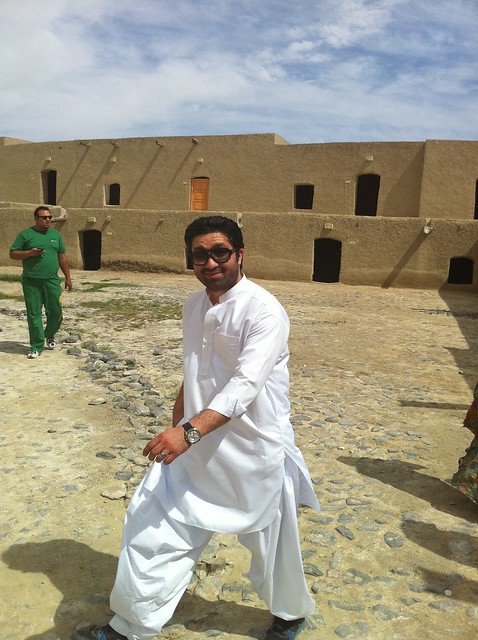
The Prohibition Era figures prominently in the collective imagination of the cocktail world. The aura and mystique surrounding that era still wields great influence on popular culture. The popularity of HBO's
Boardwalk Empire is a perfect example of our still not fully reconciled fascination with that period, as is the proliferation of modern "speakeasies" in New York and across the country. Yet despite this nostalgic intrigue, most of us have no idea what it's like to live under prohibition.
Recently I had the opportunity to have such an experience, as I traveled to Iran for a cousin's wedding. As many of you know, alcohol is prohibited in Iran, but that doesn't mean people don't find a way to get their drink on, as we sure enough did.
Breakfast of champions: grilled lamb chops, liver, heart, and lung on the roof of my cousin's house.
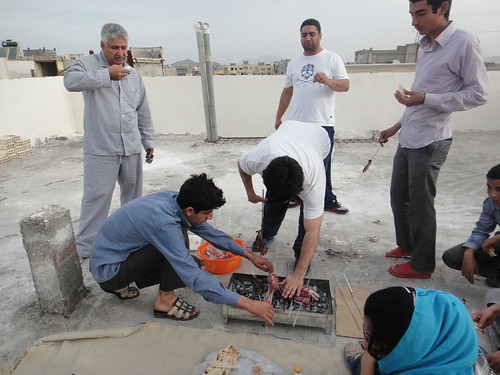
A street food vendor fanning the grill, atop which sits skewers of lamb liver. Street food in the U.S. rarely gets this good.

The wedding was in a city called
Saravan, a very rural city in the southeastern region of Iran known as
Baluchistan. The name Baluchistan means "land of the
Baluch people," the ethnic minority who have inhabited the area for hundreds of years.

The Baluchistan region spans across southeastern Iran, northwestern Pakistan, and southern Afghanistan.
[caption id="attachment_8194" align="alignnone" width="350" caption="Regional map, with Baluchistan in Pink"]
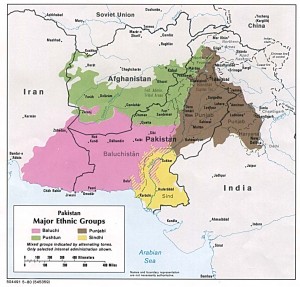
[/caption]
The area is also a veritable desert, though dates grow abound from the many palm trees dotting the region. In fact, some of the best, juiciest dates in the world come from this region.

Since my cousin was marrying a Baluchi girl, he was having a traditional Baluchi wedding, the traditions of which were unfamiliar to myself and other members of my family (who are of
Persian, not Baluchi ethnicity). My cousin, however is half Baluchi, so this was no sweat for him. As a matter of fact his grandfather was the Baluchi king of the region in his day, with grand castle and all.


The view of the town below from one of the rooms midway up the castle. The castle itself is at least 500 years old and is now a national historic site.

Henna tattoos are a common tradition at weddings in this region.
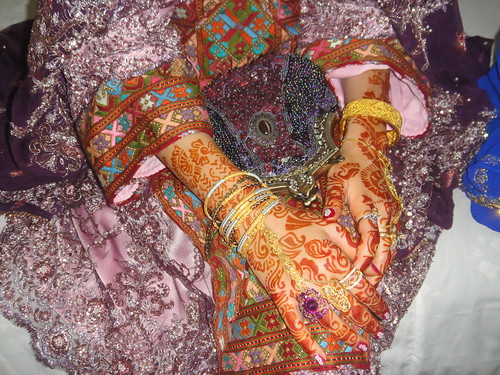

So this wedding was a big deal for a lot of people in the area--and by a lot, practically everyone. In its entirety, the wedding was a three day affair, with extravagant lunches and dinners offered on each day. To give you a sense of how extravagant, on one evening 20 goats were freshly slaughtered and smoked as part of the main dinner offering. Every day it seemed the entire town had gathered to be fed.
In America, the open bar is at least half the motivation for attending a wedding. Obviously expectations are not the same in a country like Iran where liquor is prohibited. Going dry for one wedding is bad enough, let alone a three day wedding.
A three day wedding with no bar? Ok, I can adjust my expectations and make the best of it, I figured. What I didn't anticipate, however, was that for almost every aspect of three day affair, including the lunches, dinners, tea, and dancing portions, the men and women would be in separate areas.

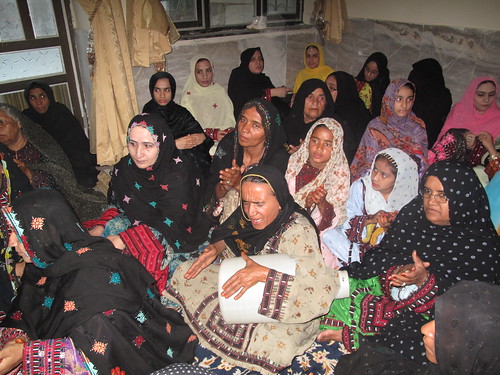
So traditional was this wedding that the men (including the groom, I believe) didn't get to see the bride until the morning after the third day. The picture of the bride below was taken by my mom, because the guys weren't even privy to this.
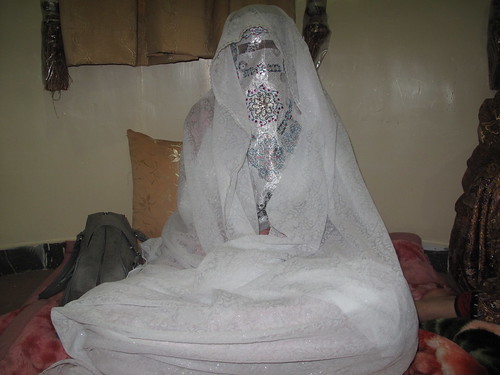
No alcohol, no problem, but kickin' it sober with a bunch of dudes? Oh man, this situation needed some amelioration.
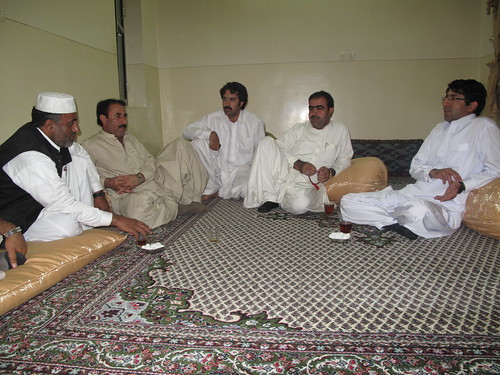
Fortunately one of my cousins (I have too many to count, but suffice it to say it wasn't the one getting married--thankfully, because that would be a disaster in waiting) felt the same way as I did, and even more fortunate was the fact that he knew a thing or two about amelioration, if you know what I mean. So he decides to score some liquor before the wedding, and asked if I wanted to come along. Naturally, I did.
We went to the local bazaar, where he knew a guy who sells textiles and cloth by the meter, but also comes across some hooch from time to time. After several minutes of shooting the obligatory shit, we end up with a packaged pouch of liquid that read "Scotch Whiskey." I was instantly skeptical, but it wasn't as if I was going to call the Better Business Bureau, so we had to take what we could get.
When we got back to his kitchen I busted it open and confirmed what I already knew, that it wasn't Scotch, and it most certainly wasn't whiskey. It was nothing more than clear, high proof bootleg alcohol. Thus my cousin received his first lesson in spirits: it ain't whiskey unless it's brown.
We needed to figure out a way to make this drink go down, so we began looking for mixing ingredients, and thus began my cousin's second lesson: how to make a balanced cocktail... in any circumstance.
We found sour cherry juice, lemons, and honey, and with a little tinkering I came up with something that was not only palatable, but actually tasted good. We found a mason jar with a lid and turned it into a makeshift shaker. I then proceeded to give them the cocktail of their lives (they'd never had a cocktail before so this was easy)--call me the Mcgyver of mixology.
I call this drink The Desert Ain't That Dry, an actual prohibition-era cocktail you could say!
The Desert Ain't That Dry
2 oz
Junior Johnson's Midnight Moon
1 1/4 oz sour cherry juice
1/2 oz fresh lemon juice
1/4 oz honey
Shake ingredients with ice and strain into a glass. No garnish necessary. We don't bother with garnishes during prohibition.
In the spirit of bootlegging I used a marketed moonshine such as Junior Johnson's, made by Piedmont Distillers in North Carolina. But you can certainly use any other brand of corn or grain alcohol, including vodka. However if you are going to use vodka I recommend using one that still has some character and flavor retained in the distillate, such as
Purity from Sweden.
As for the sour cherry juice, be aware that you may have to adjust the amount of honey from the recipe depending on how sweet the juice is. Some brands are pure sour cherry juice (more tart) and some are marketed as "nectars," which means they have added sugar and possibly water to tone down the tartness, and are thus sweeter. In Iran I used a rather tart variety with little sweetness, but here all I could find was the nectar variety with added sugar, so I had to tone down the honey significantly.
Speaking of honey, you can either use straight honey, or to make it more easily dilutable, you can make honey syrup by mixing equal parts honey and warm water until fully dissolved. The recipe above is for straight undiluted honey, so double it if using honey syrup.
Here's to repeal!
*
I'd like to express an immense amount of heartfelt gratitude to Fredo Ceraso of the lifestyle blog Loungerati for tending bar for the past several weeks while I was away.
**Got a cocktail question? Reach me on twitter @Paystyle, email me at info(at)lifesacocktail(dot)com, or simply drop me a comment below!
 The Prohibition Era figures prominently in the collective imagination of the cocktail world. The aura and mystique surrounding that era still wields great influence on popular culture. The popularity of HBO's Boardwalk Empire is a perfect example of our still not fully reconciled fascination with that period, as is the proliferation of modern "speakeasies" in New York and across the country. Yet despite this nostalgic intrigue, most of us have no idea what it's like to live under prohibition.
Recently I had the opportunity to have such an experience, as I traveled to Iran for a cousin's wedding. As many of you know, alcohol is prohibited in Iran, but that doesn't mean people don't find a way to get their drink on, as we sure enough did.
Breakfast of champions: grilled lamb chops, liver, heart, and lung on the roof of my cousin's house.
The Prohibition Era figures prominently in the collective imagination of the cocktail world. The aura and mystique surrounding that era still wields great influence on popular culture. The popularity of HBO's Boardwalk Empire is a perfect example of our still not fully reconciled fascination with that period, as is the proliferation of modern "speakeasies" in New York and across the country. Yet despite this nostalgic intrigue, most of us have no idea what it's like to live under prohibition.
Recently I had the opportunity to have such an experience, as I traveled to Iran for a cousin's wedding. As many of you know, alcohol is prohibited in Iran, but that doesn't mean people don't find a way to get their drink on, as we sure enough did.
Breakfast of champions: grilled lamb chops, liver, heart, and lung on the roof of my cousin's house.
 A street food vendor fanning the grill, atop which sits skewers of lamb liver. Street food in the U.S. rarely gets this good.
A street food vendor fanning the grill, atop which sits skewers of lamb liver. Street food in the U.S. rarely gets this good.
 The wedding was in a city called Saravan, a very rural city in the southeastern region of Iran known as Baluchistan. The name Baluchistan means "land of the Baluch people," the ethnic minority who have inhabited the area for hundreds of years.
The wedding was in a city called Saravan, a very rural city in the southeastern region of Iran known as Baluchistan. The name Baluchistan means "land of the Baluch people," the ethnic minority who have inhabited the area for hundreds of years.
 The Baluchistan region spans across southeastern Iran, northwestern Pakistan, and southern Afghanistan.
[caption id="attachment_8194" align="alignnone" width="350" caption="Regional map, with Baluchistan in Pink"]
The Baluchistan region spans across southeastern Iran, northwestern Pakistan, and southern Afghanistan.
[caption id="attachment_8194" align="alignnone" width="350" caption="Regional map, with Baluchistan in Pink"] [/caption]
The area is also a veritable desert, though dates grow abound from the many palm trees dotting the region. In fact, some of the best, juiciest dates in the world come from this region.
[/caption]
The area is also a veritable desert, though dates grow abound from the many palm trees dotting the region. In fact, some of the best, juiciest dates in the world come from this region.
 Since my cousin was marrying a Baluchi girl, he was having a traditional Baluchi wedding, the traditions of which were unfamiliar to myself and other members of my family (who are of Persian, not Baluchi ethnicity). My cousin, however is half Baluchi, so this was no sweat for him. As a matter of fact his grandfather was the Baluchi king of the region in his day, with grand castle and all.
Since my cousin was marrying a Baluchi girl, he was having a traditional Baluchi wedding, the traditions of which were unfamiliar to myself and other members of my family (who are of Persian, not Baluchi ethnicity). My cousin, however is half Baluchi, so this was no sweat for him. As a matter of fact his grandfather was the Baluchi king of the region in his day, with grand castle and all.

 The view of the town below from one of the rooms midway up the castle. The castle itself is at least 500 years old and is now a national historic site.
The view of the town below from one of the rooms midway up the castle. The castle itself is at least 500 years old and is now a national historic site.
 Henna tattoos are a common tradition at weddings in this region.
Henna tattoos are a common tradition at weddings in this region.

 So this wedding was a big deal for a lot of people in the area--and by a lot, practically everyone. In its entirety, the wedding was a three day affair, with extravagant lunches and dinners offered on each day. To give you a sense of how extravagant, on one evening 20 goats were freshly slaughtered and smoked as part of the main dinner offering. Every day it seemed the entire town had gathered to be fed.
In America, the open bar is at least half the motivation for attending a wedding. Obviously expectations are not the same in a country like Iran where liquor is prohibited. Going dry for one wedding is bad enough, let alone a three day wedding.
A three day wedding with no bar? Ok, I can adjust my expectations and make the best of it, I figured. What I didn't anticipate, however, was that for almost every aspect of three day affair, including the lunches, dinners, tea, and dancing portions, the men and women would be in separate areas.
So this wedding was a big deal for a lot of people in the area--and by a lot, practically everyone. In its entirety, the wedding was a three day affair, with extravagant lunches and dinners offered on each day. To give you a sense of how extravagant, on one evening 20 goats were freshly slaughtered and smoked as part of the main dinner offering. Every day it seemed the entire town had gathered to be fed.
In America, the open bar is at least half the motivation for attending a wedding. Obviously expectations are not the same in a country like Iran where liquor is prohibited. Going dry for one wedding is bad enough, let alone a three day wedding.
A three day wedding with no bar? Ok, I can adjust my expectations and make the best of it, I figured. What I didn't anticipate, however, was that for almost every aspect of three day affair, including the lunches, dinners, tea, and dancing portions, the men and women would be in separate areas.

 So traditional was this wedding that the men (including the groom, I believe) didn't get to see the bride until the morning after the third day. The picture of the bride below was taken by my mom, because the guys weren't even privy to this.
So traditional was this wedding that the men (including the groom, I believe) didn't get to see the bride until the morning after the third day. The picture of the bride below was taken by my mom, because the guys weren't even privy to this.
 No alcohol, no problem, but kickin' it sober with a bunch of dudes? Oh man, this situation needed some amelioration.
No alcohol, no problem, but kickin' it sober with a bunch of dudes? Oh man, this situation needed some amelioration.
 Fortunately one of my cousins (I have too many to count, but suffice it to say it wasn't the one getting married--thankfully, because that would be a disaster in waiting) felt the same way as I did, and even more fortunate was the fact that he knew a thing or two about amelioration, if you know what I mean. So he decides to score some liquor before the wedding, and asked if I wanted to come along. Naturally, I did.
We went to the local bazaar, where he knew a guy who sells textiles and cloth by the meter, but also comes across some hooch from time to time. After several minutes of shooting the obligatory shit, we end up with a packaged pouch of liquid that read "Scotch Whiskey." I was instantly skeptical, but it wasn't as if I was going to call the Better Business Bureau, so we had to take what we could get.
When we got back to his kitchen I busted it open and confirmed what I already knew, that it wasn't Scotch, and it most certainly wasn't whiskey. It was nothing more than clear, high proof bootleg alcohol. Thus my cousin received his first lesson in spirits: it ain't whiskey unless it's brown.
We needed to figure out a way to make this drink go down, so we began looking for mixing ingredients, and thus began my cousin's second lesson: how to make a balanced cocktail... in any circumstance.
We found sour cherry juice, lemons, and honey, and with a little tinkering I came up with something that was not only palatable, but actually tasted good. We found a mason jar with a lid and turned it into a makeshift shaker. I then proceeded to give them the cocktail of their lives (they'd never had a cocktail before so this was easy)--call me the Mcgyver of mixology.
I call this drink The Desert Ain't That Dry, an actual prohibition-era cocktail you could say!
The Desert Ain't That Dry
2 oz Junior Johnson's Midnight Moon
1 1/4 oz sour cherry juice
1/2 oz fresh lemon juice
1/4 oz honey
Shake ingredients with ice and strain into a glass. No garnish necessary. We don't bother with garnishes during prohibition.
In the spirit of bootlegging I used a marketed moonshine such as Junior Johnson's, made by Piedmont Distillers in North Carolina. But you can certainly use any other brand of corn or grain alcohol, including vodka. However if you are going to use vodka I recommend using one that still has some character and flavor retained in the distillate, such as Purity from Sweden.
As for the sour cherry juice, be aware that you may have to adjust the amount of honey from the recipe depending on how sweet the juice is. Some brands are pure sour cherry juice (more tart) and some are marketed as "nectars," which means they have added sugar and possibly water to tone down the tartness, and are thus sweeter. In Iran I used a rather tart variety with little sweetness, but here all I could find was the nectar variety with added sugar, so I had to tone down the honey significantly.
Speaking of honey, you can either use straight honey, or to make it more easily dilutable, you can make honey syrup by mixing equal parts honey and warm water until fully dissolved. The recipe above is for straight undiluted honey, so double it if using honey syrup.
Here's to repeal!
*I'd like to express an immense amount of heartfelt gratitude to Fredo Ceraso of the lifestyle blog Loungerati for tending bar for the past several weeks while I was away.
**Got a cocktail question? Reach me on twitter @Paystyle, email me at info(at)lifesacocktail(dot)com, or simply drop me a comment below!
Fortunately one of my cousins (I have too many to count, but suffice it to say it wasn't the one getting married--thankfully, because that would be a disaster in waiting) felt the same way as I did, and even more fortunate was the fact that he knew a thing or two about amelioration, if you know what I mean. So he decides to score some liquor before the wedding, and asked if I wanted to come along. Naturally, I did.
We went to the local bazaar, where he knew a guy who sells textiles and cloth by the meter, but also comes across some hooch from time to time. After several minutes of shooting the obligatory shit, we end up with a packaged pouch of liquid that read "Scotch Whiskey." I was instantly skeptical, but it wasn't as if I was going to call the Better Business Bureau, so we had to take what we could get.
When we got back to his kitchen I busted it open and confirmed what I already knew, that it wasn't Scotch, and it most certainly wasn't whiskey. It was nothing more than clear, high proof bootleg alcohol. Thus my cousin received his first lesson in spirits: it ain't whiskey unless it's brown.
We needed to figure out a way to make this drink go down, so we began looking for mixing ingredients, and thus began my cousin's second lesson: how to make a balanced cocktail... in any circumstance.
We found sour cherry juice, lemons, and honey, and with a little tinkering I came up with something that was not only palatable, but actually tasted good. We found a mason jar with a lid and turned it into a makeshift shaker. I then proceeded to give them the cocktail of their lives (they'd never had a cocktail before so this was easy)--call me the Mcgyver of mixology.
I call this drink The Desert Ain't That Dry, an actual prohibition-era cocktail you could say!
The Desert Ain't That Dry
2 oz Junior Johnson's Midnight Moon
1 1/4 oz sour cherry juice
1/2 oz fresh lemon juice
1/4 oz honey
Shake ingredients with ice and strain into a glass. No garnish necessary. We don't bother with garnishes during prohibition.
In the spirit of bootlegging I used a marketed moonshine such as Junior Johnson's, made by Piedmont Distillers in North Carolina. But you can certainly use any other brand of corn or grain alcohol, including vodka. However if you are going to use vodka I recommend using one that still has some character and flavor retained in the distillate, such as Purity from Sweden.
As for the sour cherry juice, be aware that you may have to adjust the amount of honey from the recipe depending on how sweet the juice is. Some brands are pure sour cherry juice (more tart) and some are marketed as "nectars," which means they have added sugar and possibly water to tone down the tartness, and are thus sweeter. In Iran I used a rather tart variety with little sweetness, but here all I could find was the nectar variety with added sugar, so I had to tone down the honey significantly.
Speaking of honey, you can either use straight honey, or to make it more easily dilutable, you can make honey syrup by mixing equal parts honey and warm water until fully dissolved. The recipe above is for straight undiluted honey, so double it if using honey syrup.
Here's to repeal!
*I'd like to express an immense amount of heartfelt gratitude to Fredo Ceraso of the lifestyle blog Loungerati for tending bar for the past several weeks while I was away.
**Got a cocktail question? Reach me on twitter @Paystyle, email me at info(at)lifesacocktail(dot)com, or simply drop me a comment below!




Comments (3)
great post! I’m iranian, but all of my family is from tehran, so it’s nice to get a window into one of more rural areas of the country. nice score on the booze too!
Wow I never knew you were Persian. Very interesting. My mom’s side is from Tehran, and my dad’s side is from Zahedan. I was born in Tehran, and the first time I traveled to Zahedan as an adult was a real eye opening experience.
Wow, this is an amazingly informative post. I learned a lot about the culture just from this one anecdote. Incredible photos. -Louisa